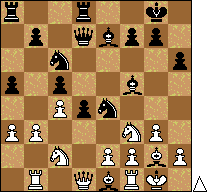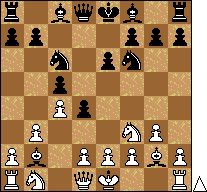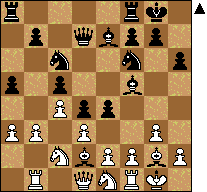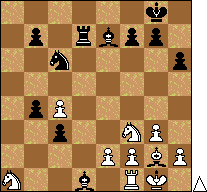Round 5 of Pittsburgh Chess Club Tournament: On Benoni "Emasculation" and Learning
Oct 2, 2012 · 8 minute read · CommentschessPittsburghPittsburgh Chess ClubSicilian DefenseEnglish OpeningMaróczy BindBenonilearning

White in reverse Benoni being crushed
Tonight was the fifth (and penultimate) round of the current six-round Tuesday night tournament at the Pittsburgh Chess Club, the 14th Fred Sorensen Memorial. I last reported on the third round, rather than the fourth round, because as I mentioned in August upon signing up for the tournament, I took a bye for the fourth round because of a schedule conflict with a Pittsburgh Java User Group meeting that I wanted to attend.
Thankfully, I came back for the fifth round finding that I was still tied for first, despite taking a half point bye in the fourth round, because nobody else had a perfect score after four rounds either.
The game tonight ended up one-sided; right after he resigned, he called it an “emasculation” (I won fairly quickly, in less than two hours). However:
- the unfolding of the game provides what I think is a nice illustration of how to win thematically against a Benoni opening structure
- my opponent and I had a good discussion, after the game, about learning and improvement
The complete annotated game
At your convenience, you can enjoy playing over the game with my annotations, including diagrams.
The paradox of choice: how to play against the English Opening as Black?
I learned some days before tonight’s game that my opponent and I were going to be paired. Based on my memory, and my database of games, I expected my opponent to play the English Opening. In our last game, in 2010, he had played the English. I planned to avoid the variation that I had played then, because of course he would be prepared for it.
Reverse Sicilian?
I have a confession to make: in the past, I hated facing the English Opening as Black. It’s the paradox of choice: there are so many different ways to play against it. It is not a forcing, direct opening the way 1 e4 and 1 d4 are. In its purest form, in fact, it is a psychological trick, an attempt to play a Sicilian Defense in reverse, but with an extra move, if Black takes up the challenge of playing 1... e5. That extra move makes a huge difference, both objectively and psychologically, in the kinds of positions and evaluations that can arise, as noted English Opening theoretician John Watson has brilliantly explained. Roughly, it’s like playing the Sicilian Defense but getting an extra punch in before the fight starts.
In my 2010 game against my opponent, I in fact took up the challenge as Black and went into an aggressive reversed Sicilian variation, one tempo down: I played the Rubinstein Variation, which is exactly the Maróczy Bind in reverse. This is very risky, and although I won that game, I have also lost playing it. I do not play that kind of reversed Sicilian any more.
Alternatives
There are many, many alternatives to playing for a reverse Sicilian as Black. Tonight I chose to aim to fight for the d5 square, to play to occupy the center and Queen side.
Overview of my game
The opening
As expected, my opponent played 1 c4, the English Opening. After some more moves, it turned out that my opponent allowed me to play a reversed Benoni.
Again, there are dangers in playing reversed openings, in which Black takes the aggressive role White ordinarily takes but with a tempo down, but in this case, because of a positional subtlety, I was allowed to play a good version of the reversed Benoni as Black:

A good reversed Benoni for Black
The problem for White is that he used his extra moves to play b3 and Bb2, but now the Bishop is blocked up and is misplaced. This is an example of what proponents of the Black pieces such as John Watson and András Adorján have observed about the subtleties of having extra moves: sometimes they are committal and do not help the side which has them!
Concepts of the Benoni
For those who are not very familiar with the Benoni as a chess opening, here is an overview of the goals of the two sides, which I’ll call the attacker and the counter-attacker (in the regular Benoni, these are White and Black, respectively, and in the reversed Benoni, these are Black and White, respectively).
Note that I don’t mention a role defender here, because this opening is so sharp and aggressive for both sides that really, both sides are simultaneously attacking and defending for their lives. This opening is not for the faint-hearted for either side! It is a “kill or be killed” type of opening. I have played the Benoni on both sides, and both killed and been killed. (Most recently, I played the counter-attacking role against a boy in a casual game and broke through quickly.)
The attacker has more space, has a center pawn wedge thrust into the innards of the counter-attacker’s position, and aims to squeeze the counter-attacker to death, preventing Queen side counterplay, while preparing to blast through at the tip of the pawn wedge.
The counter-attacker has less space, and hopes to launch a flank attack on the back end of the attacker’s pawn wedge and destroy the attacker’s center, coming around the attacker’s weakened Queen side to swarm in that way.
The middle
The game tonight had the counter-attacker never getting Queen side counterplay off the ground, while the attacker (Black) broke through without resistance in the center: note that Black has played e4 successfully and White’s thematic b4 is nowhere near possible.

e pawn advance against the Benoni
The end
There was no real end game to speak of, since by the time Queens came off the board, the game was lost for White.

Queens are off, but game is over
Discussion with my opponent
After the game, my opponent and I discussed the errors that he made during the game: I considered that allowing the reverse Benoni after b3 and Bb2 was an error, and then after that, failing to prevent e4 with Nd2 was an error.
Study
He noted that he had prepared for our game by studying our game in 2010 and had improved his understanding of the opening variation we had played then, but I told him that I, too, had looked at the game, and never planned to walk into his preparation. He said that he had every confidence that if I had played the same opening variation, I would have done my homework also, to improve what I did last time. He said he respected that even against a weaker player such as himself, he trusted that I would not play an opening I considered inferior or unsound just because I could get away it. I really appreciated this comment and statement of trust, because in fact this is my current serious attitude. In a blitz game, I might play around, but in a serious tournament game, I will no longer play “junk”. This was not always the case. In fact, in one of our earliest games, years ago, I had played junk against him and won, but not felt happy about doing that.
Learning
I congratulated him for doing his homework, and having improved so much in the past couple of years, and he said he learns from his mistakes. Bravo! I have no doubt that he will study the opening we played today and be ready in the future not just for me, but anyone who plays how I did today. Some people make the mistake, during these Tuesday night tournaments in which we face the same people repeatedly, of preparing one-shot ideas against specific opponents, but what we really want to do (and what he does and what I do) is use these rematches as excuses to improve our general knowledge and skill.
My opponent said, before we parted tonight, “I don’t learn from my wins. I learn from my losses.”
I would amend that remark, however. I try to learn from my wins as well. Just because I won this game doesn’t mean I haven’t gone and analyzed where I could have won even faster or possible good moves he could have made that I overlooked. Every game that I play, whether I win or lose, I want to learn something from. I have won games in which I played horribly and didn’t see anything and only won because my opponent saw less. I’m not satisfied with just seeing more than someone else; I actually want to see the naked truth.
What next?
Next Tuesday is the last round of the six-round tournament. I am now the undisputed leader for first, meaning that if I draw next week, I am guaranteed at least a tie for first prize; if I win, I get clear first prize.
None of that really matters to me. I’m in this to play as well as I can, enjoy the art, enjoy the sport, and to write up everything I learn along the way, whether I win, draw, or lose. I am, of course, grateful that I have been winning.
(Update of 2012-10-07)
Oops, it turns out that I was wrong in figuring that I was the undisputed leader for first going into the final round: in fact, someone took a bye in the fifth round after a perfect score in the first four rounds, so he and I are tied for first going into the final round, and in fact, we are playing each other on Tuesday. So if I draw, that only guarantees that we split first prize. I need to win in order to get clear first prize.
I am, of course, playing for a win. For better or for worse, I have never played for a draw in my life, against anyone, even a Grandmaster.
Conclusion
Tonight I got a chance to play an opening, reverse Benoni, that I haven’t played for some time in a tournament, and I won the game through clear, thematic moves. In addition, we had a pleasant discussion after the game, and I look forward to seeing him play better in this opening in the future, and I too will refine my play in it.